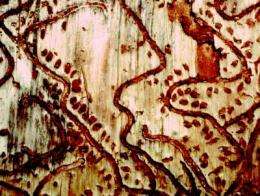This shows the characteristic S-shaped galleries of the southern pine beetle. The dark blue-black areas are inoculated with blue-stain fungi. Credit: Ron Billings
The southern pine beetle, Dendroctonus frontalis Zimmermann, is a chronic insect pest within pine forests in the southeastern United States. Under favorable environmental and host conditions, it is an aggressive, primary bark beetle capable of killing large acreages of pines. Its principal range stretches from east Texas and Oklahoma to the east coast and north to southern New Jersey.
In "Implications of Population Phases on the Integrated Pest Management of the Southern Pine Beetle, Dendroctonus frontalis," a new article appearing in the Journal of Integrated Pest Management, author Stephen Clarke of the USDA Forest Services provides recommendations on how an integrated pest management (IPM) program for the southern pine beetle should be implemented.
The southern pine beetle has three population phases. In the latent phase, infestations are absent. In the outbreak phase, one or more multi-tree infestations are detected per 1,000 acres of susceptible host type, and the southern pine beetle acts as an aggressive primary colonizer. The intermediate phase consists of population levels between the aforementioned latent and outbreak phases.
The characteristics of these three phases have management implications, and the IPM program for the southern pine beetle should be tailored for each one. Prevention and restoration are primary management concerns in the latent phase, whereas suppression takes precedence during an outbreak.
Besides providing information on the southern pine beetle biology and phases, Dr. Clarke also discusses methods of prediction, aerial detection, ground evaluation, suppression and prevention of the beetle.
More information: The full article is available for free at bit.ly/wSKL4W
Provided by Entomological Society of America




















